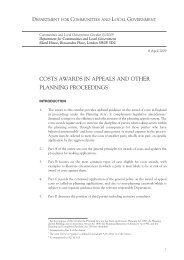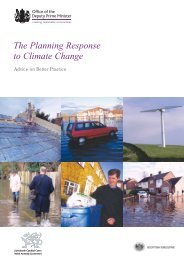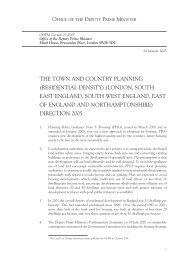PERMITTED DEVELOPMENT RIGHTS FOR ANTENNAS
Circular 10/05: Permitted Development Rights for Antennas - Gov.uk
Circular 10/05: Permitted Development Rights for Antennas - Gov.uk
- No tags were found...
You also want an ePaper? Increase the reach of your titles
YUMPU automatically turns print PDFs into web optimized ePapers that Google loves.
OFFICE OF THE DEPUTY PRIME MINISTERODPM Circular 10/2005Office of the Deputy Prime MinisterEland House, Bressenden Place, London SWIE 5DU25 November 2005<strong>PERMITTED</strong> <strong>DEVELOPMENT</strong> <strong>RIGHTS</strong><strong>FOR</strong> <strong>ANTENNAS</strong>INTRODUCTION1. This Circular gives guidance on the permitted development rights for antennas foundin Part 1, Class H and Part 25, Class A and Class B of the Town and Country Planning(General Permitted Development) Order 1995 (the GPDO).2. This Order was amended by Statutory Instrument 2935/2005, and comes into force on25th November 2005. These amendments follow extensive consultation about thechanges considered necessary to reflect the changes in antenna technology andperceived future demand for such technologies.3. It should be remembered, however, that although this Circular gives guidanceamounting to an interpretation of the Order, only the courts can interpret the lawauthoritatively.BACKGROUND4. The planning system is concerned with regulating the use of land in the public interest.The Town and Country Planning (General Permitted Development) Order 1995 (theGPDO) is intended to be a deregulatory mechanism that works by lessening theregulatory requirements of the planning system. By granting permission for specifiedtypes of relatively uncontentious development, the resources of the planning system canbe deployed more efficiently.1
5. As permitted development rights play a vital role in the planning system, it is importantthat they remain up to date and appropriate. The provisions in the GPDO for antennaswere introduced in 1991, with amendments made in 1998 and 1999. They apply onlyto satellite dishes. Since then, however, significant technological advancements havebeen made – the development of broadband, for example. There is now a wide range ofequipment used to deliver electronic communications, some of which does not fallwithin these permitted development rights. Therefore, in order to bring the GPDO upto date and to ensure that it does not discriminate between technologies, it is necessaryto make amendments.6. However, in setting the limits for permitted development, there is a balance to be struckbetween giving freedoms to individual householders and safeguarding the environment.The limitations and restrictions on permitted development rights for antennas areintended to protect the environment from unnecessarily large, unsympathetic or poorlysited antennas. This applies particularly in designated areas - such as conservation areasand Areas of Outstanding Natural Beauty.DEFINITION OF ANTENNA7. Any reference to ‘antennas’ should be taken as referring to all microwave 1 antennas,25 defined in Article 1(2) of the order. This term covers both microwave and satelliteantennas 2 .8. Generally, most conventional TV aerials (including their mountings and poles) havenot been considered as being development, and therefore have not required planningconsent because they are considered to be de minimis 3 .DESIGNATED AREAS9. Designated Areas refer to Conservation Areas, Areas of Outstanding Natural Beauty,the National Parks, and the Norfolk and Suffolk Broads. They are specified in Schedule1, Part 2: Article 1(5) of the GPDO (and are often referred to as ‘Article 1(5) land’) asbeing land requiring additional protection from adverse visual impact.10. There are special restrictions regarding the siting of antennas on buildings in designatedareas.1The term ‘microwave’ refers to that part of the radio spectrum above 1,000 MHz.2Satellite dishes also use microwave frequencies, but they are transmitted from the geo-orbital satellite rather thanterrestrially; they have a distinctive appearance and have unique line-of-sight requirements.3De Minimis - the shortened version of ‘de minimis non curat lex’ - is a legal maxim roughly translated as "the law doesnot concern itself with trifles." It is legal principle applied by the courts and, as such, is not described or dealt with inthe Planning Acts. It is applied where a trifling infringement is brought to the attention of the court, but where thedeviation is of so little consequence that, if continued, would weigh little or nothing in the public interest and mightproperly be overlooked. What is treated as de minimis is the decision of the courts based on the facts of the case. It isnot within the gift of the Local Authority Planning Departments, nor the ODPM, to decide whether or where theprinciple should be applied, nor can the decision of the courts be anticipated in this way.2
LISTED BUILDINGS11. There are separate controls for work affecting listed buildings. The installation ofantennas on a listed building will usually require listed building consent.<strong>PERMITTED</strong> <strong>DEVELOPMENT</strong> <strong>RIGHTS</strong>12. The planning regulations for antennas within the GPDO relate to:• dwelling houses (Part 1, Class H of the GPDO)• buildings 15m or more in height (Part 25, Class A of the GPDO)• buildings below 15m in height (Part 25, Class B of the GPDO)13. In all cases, there are additional restrictions for buildings in designated areas.Annex A: sets out the permitted development rights for antennas installed on dwellinghouses, and dwelling houses in designated areas.Annex B: sets out the permitted development rights for antennas installed on buildingsunder 15m (excluding dwelling houses) and such buildings in designated areas.Annex C: sets out the permitted development rights for antennas installed on buildings15m or more in height, and such buildings in designated areas.14. The regulations are formatted around three elements:• the number of antennas ;• the size of antennas;• the location restrictions of antennas.NUMBERS OF <strong>ANTENNAS</strong>15. The permitted development rights provided by the GPDO, as amended, allow twoantennas on buildings below 15m (including dwelling houses); and four on buildings15m or more in height.SIZE OF <strong>ANTENNAS</strong>16. The sizes of antennas permitted by the GPDO for buildings below 15m in height(including dwelling houses) are, in the case of single antennas, up to 100cm in length;and in the case of any second antenna, up to 60cm in length. For buildings 15m or morein height, the maximum size for antennas is 130cm in length. For all buildings, chimneymounted antennas have a maximum size of 60cm in length.17. The size of antennas is defined by cubic capacity as well as by length (linear dimension).This is because there are now a number of antennas which have a more pronouncedthree-dimensional profile than, for example, satellite dishes. The maximum cubiccapacity is 35 litres. Antennas larger than 100cm in any linear dimension or 35 litrescubic capacity would require planning permission.3
LOCATION OF <strong>ANTENNAS</strong>18. For buildings below 15m in height (including dwelling houses), antennas are permittedto protrude above the highest part of the roof if the building has a chimney. In suchcases, antennas may protrude by up to 60cm or the height of the chimney, whichever isthe lower. For buildings 15m or more in height, antennas are permitted to protrudeabove the highest part of the roof by up to 300cm. In all cases, antennas are notpermitted to protrude above a chimney stack.19. There are further restrictions for all types of building located in designated areas.Antennas are not permitted on a chimney, wall or roof slope which both faces onto andis visible from a road or a Broads waterway. The visibility requirement ensures thatrestrictions are not imposed unnecessarily.20. Further good practice guidance may be found in the ODPM pamphlet, A Householders’Planning Guide to the Installation of Antennas available on the ODPM website.JOHN STAMBOLLOUIANHead of Planning Development Control Division,Office of Deputy Prime MinisterAddressed to:The Chief Executives of:County Councils in England;District Councils in EnglandUnitary Authorities in EnglandLondon Borough CouncilsGreater London AuthorityRegional Planning BodiesRegional Development AgenciesCouncil of the Isles of ScillyThe Town Clerk, City of LondonThe National Park Officer, National Park Authorities in EnglandThe Chief Planning Officer, The Broads Authority4
Annex APermitted Development for Antennas on Dwelling HousesThe regulations relating to antennas on dwelling houses are contained in the followingtable:Numbers of antenna(s)Size of antenna(s)Location restrictionsRestrictions inDesignated AreasUp to 2 antennas are permitted.Single antennas are permitted to be up to 100 cm inlength.For 2 antennas, one is permitted to be up to 100cm inlength; any second antenna is limited to 60 cm inlength.Chimney-mounted antennas are limited to 60cm inlength.All antennas should be no greater than 35 litres cubiccapacity.In dwelling houses which have a chimney stack:antennas should not protrude above the highest partof the roof by more than 60cm, or the highest part ofthe chimney, whichever is the lower.In dwelling houses without a chimney stack: antennasshould not protrude above the highest part of theroof.Antennas should not protrude above the highestpoint of the chimney.Antennas are not permitted on a chimney, wall orroof slope which both faces onto and is visible from aroad or a Broads waterway.5
Annex BPermitted Development for Antennas on Buildings under 15m in heightThe regulations relating to antennas on buildings under 15m in height (but not dwellinghouses) are contained in the following table:Numbers of antenna(s)Size of antenna(s)Location restrictionsRestrictions inDesignated AreasUp to 2 antennas are permitted.Single antennas are permitted to be up to 100 cm inlength.For 2 antennas, only one is permitted to be up to100cm in length; any second antenna is limited to 60cm in length.Chimney-mounted antennas are limited to 60cm inlength.All antennas should be no greater than 35 litres cubiccapacity.In buildings with a chimney stack: antennas shouldnot exceed the highest part of the roof by more than60cm, or the highest part of the chimney, whichever isthe lower.In buildings without a chimney stack: antennasshould not exceed the highest part of the roof.Antennas should not protrude above the highestpoint of the chimney.Antennas are not permitted on a chimney, wall orroof slope which both faces onto and is visible from, aroad or a Broads waterway.6
Annex CPermitted Development for Antennas on Buildings 15m or more in heightThe regulations relating to antennas on buildings 15m in height or more are containedin the following table:Numbers of antenna(s)Size of antenna(s)Location restrictionsRestrictions inDesignated AreasUp to 4 antennas are permitted.All antennas are permitted to be up to 130 cm inlength.Chimney-mounted antennas are limited to 60cm inlength.All antennas should be no greater than 35 litres cubiccapacity.Antennas should not exceed the highest part of theroof by more than 300cm.Antennas are not permitted on a chimney, wall orroof slope which both faces onto and is visible from aroad or a Broads waterway.7
Published by TSO (The Stationery Office) and available from:Onlinewww.tsoshop.co.ukMail,Telephone, Fax & E-mailTSOPO Box 29, Norwich, NR3 1GNTelephone orders/General enquiries: 0870 600 5522Fax orders: 0870 600 5533E-mail: book.orders@tso.co.ukTextphone 0870 240 3701TSO Shops123 Kingsway, London,WC2B 6PQ020 7242 6393 Fax 020 7242 639468-69 Bull Street, Birmingham B4 6AD0121 236 9696 Fax 0121 236 96999-21 Princess Street, Manchester M60 8AS0161 834 7201 Fax 0161 833 063416 Arthur Street, Belfast BT1 4GD028 9023 8451 Fax 028 9023 540118-19 High Street, Cardiff CF10 1PT029 2039 5548 Fax 029 2038 434771 Lothian Road, Edinburgh EH3 9AZ0870 606 5566 Fax 0870 606 5588TSO Accredited Agents(see Yellow Pages)and through good booksellers© Crown copyright 2005Copyright in the typographical arrangements rests with the Crown.Published for the Office of the Deputy Prime Minister, under licence from the Controller ofHer Majesty’s Stationery Office.Extracts of up to 10 per cent of this publication may be photocopied for non-commercial in-houseuse, subject to to the source being acknowledged.Application for reproduction should be made in writing toThe Copyright Unit, Her Majesty’s Stationery Office,St Clements House, 1-17 Colegate, Norwich NR3 1BQ.Printed by The Stationery Office Ltd under the authority and superintendence of the Controller ofHer Majesty’s Stationery Office and Queen’s Printer of Acts of Parliament.ISBN 0 11 753957 0£6www. tso.co.uk








